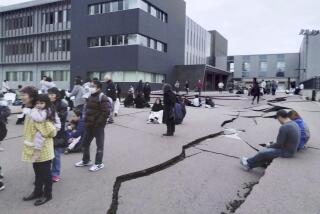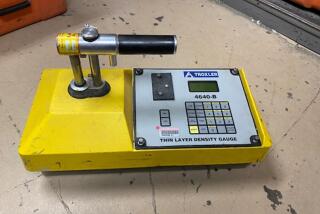Radiation scare highlights perils of information
For the better part of Sunday, media outlets in Japan and around the world carried scary-sounding news about radiation at the stricken Fukushima nuclear plant’s No. 2 reactor. In a typical report, Japanese broadcaster NHK said: “Power company says it has detected radioactive materials 10 million times normal levels.”
After nightfall came the mea culpa. There was a “mistake in the measurement of the assessment” of radiation in a building near the reactor, Tokyo Electric Power Co. said on its website. But then early Monday, a technical chart published on the company’s website indicated another, different, level.
The new chart said the level of radiation was above 1,000 millisieverts per hour, meaning a worker would reach the annual maximum exposure limit of 250 millisieverts in 15 minutes or less. Tepco said that meant the levels were about 100,000 times those at a normally functioning reactor — still high, but far below the first number.
The rush to publicize the first radiation reading, the retraction and revision underscored the intense pressure Japanese officials and Tepco executives now face in keeping the public abreast of the situation at the plant.
In the first few days after the March 11 earthquake and tsunami that damaged the Fukushima Daiichi power plant, government authorities and the company were criticized for not providing information in a timely fashion. A Kyodo News survey released Sunday found that 58% of respondents did not approve of the government’s handling of the crisis at the nuclear plant.
More than two weeks later, updates provided via news conferences, press releases, data charts and Twitter feeds have become very frequent and very technical. To a lay person, the onslaught of numbers and unfamiliar terms can feel indecipherable.
“The question is, what is a reasonable interval to give people information?” said Dr. Robert Peter Gale, an American physician and expert on radiation who consulted on the 1986 nuclear disaster in Chernobyl and is now advising Japan’s government. “Instead of just releasing each data point you get, sometimes it’s better to base things on an average of readings over a period of time.”
Gale said governments frequently struggle in the early days of a radiation crisis with how to disseminate information to the public in a way that is timely, accurate and informative.
“This is a common problem, a generic issue,” Gale said Sunday in an interview in Tokyo, a day after visiting the Fukushima facility. “But once credibility is lost, it’s very difficult to recover.”
Chief Cabinet Secretary Yukio Edano said a senior Tepco executive had paid a visit to the prime minister’s office Monday to explain the inaccurate readings.
“I can imagine that the workers at the site are extremely fatigued. At the same, these radioactivity measurements are taken as a safety precaution, and this kind of mistake is unacceptable. That’s what we told Tepco,” Edano said.
These days, a person in Tokyo concerned about radiation from Fukushima can check the Ministry of Education, Culture, Sports, Science and Technology’s website for daily atmospheric radiation readings by prefecture across the nation, as well as levels in drinking water.
The Ministry of Land, Infrastructure, Transportation and Tourism has sections on radiation levels around airports and near Yokohama, Kawasaki, Chiba and the port of Tokyo. The Ministry of Health, Labor and Welfare’s website has notices about Japan’s policies on handling of food possibly contaminated by radioactive substances, as does the Food and Safety Commission’s site.
Then there are daily briefings from Edano, Tokyo Electric Power Co., the Nuclear and Industrial Safety Agency and, less frequently, Prime Minister Naoto Kan. Adding to the din of information are the Nuclear Safety Commission, the Tokyo Metropolitan government, daily newspapers, radio, television and websites, not to mention the amateur nuclear experts around Japan who have set up webcams broadcasting images of their own Geiger counters 24 hours a day.
Around lunchtime Sunday, Japanese government officials said Tepco had informed them that the company had found puddles at the Fukushima facility’s No. 2 reactor turbine building containing 10 million times more radioactivity than would be found in water in a normally functioning nuclear reactor.
The disclosure raised questions about the source of the radioactivity and the extent of damage to the plant, as well as the threat to workers trying to stabilize the situation at Fukushima. Last week, two workers were hospitalized after being exposed to radioactive water in a different building, but the level of radiation in that situation was said to be much lower.
But some experts expressed doubts about the number.
“If nuclear fission had occurred, Tepco should have detected other radioactive elements but didn’t, which I don’t quite understand,” said Seiji Shiroya, an official with the Nuclear Safety Commission, which serves as a backup to the main regulatory agency, the Nuclear and Industrial Safety Agency. “I don’t think the measurement is accurate.”
Nuclear and Industrial Safety Agency spokesman Tatsuji Narita said the agency had received word from Tepco that the company believed its initial reading might have been wrong and that it was rechecking the radiation levels in the turbine building.
“We are waiting for Tepco to get back to us with new results,” Narita said.
Then, late Sunday, Tepco said the figure was in error and apologized but did not explain how the mistake was made.
More: Articles, videos and graphics on radiation exposure, nuclear crisis
Hall is a special correspondent.
More to Read
Start your day right
Sign up for Essential California for news, features and recommendations from the L.A. Times and beyond in your inbox six days a week.
You may occasionally receive promotional content from the Los Angeles Times.







